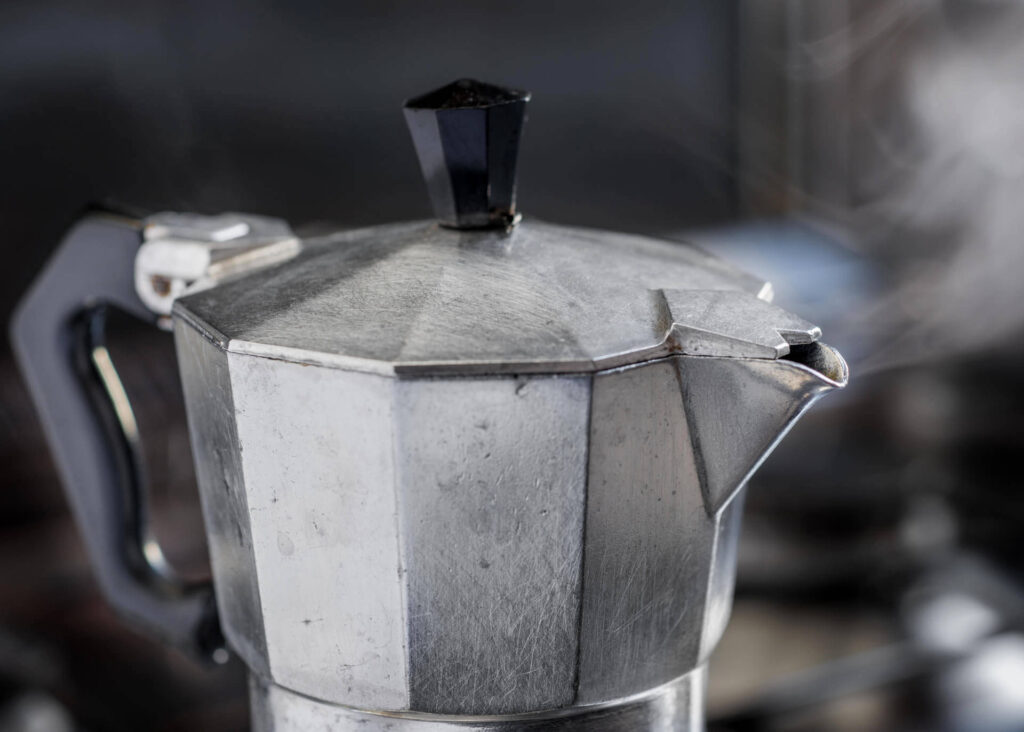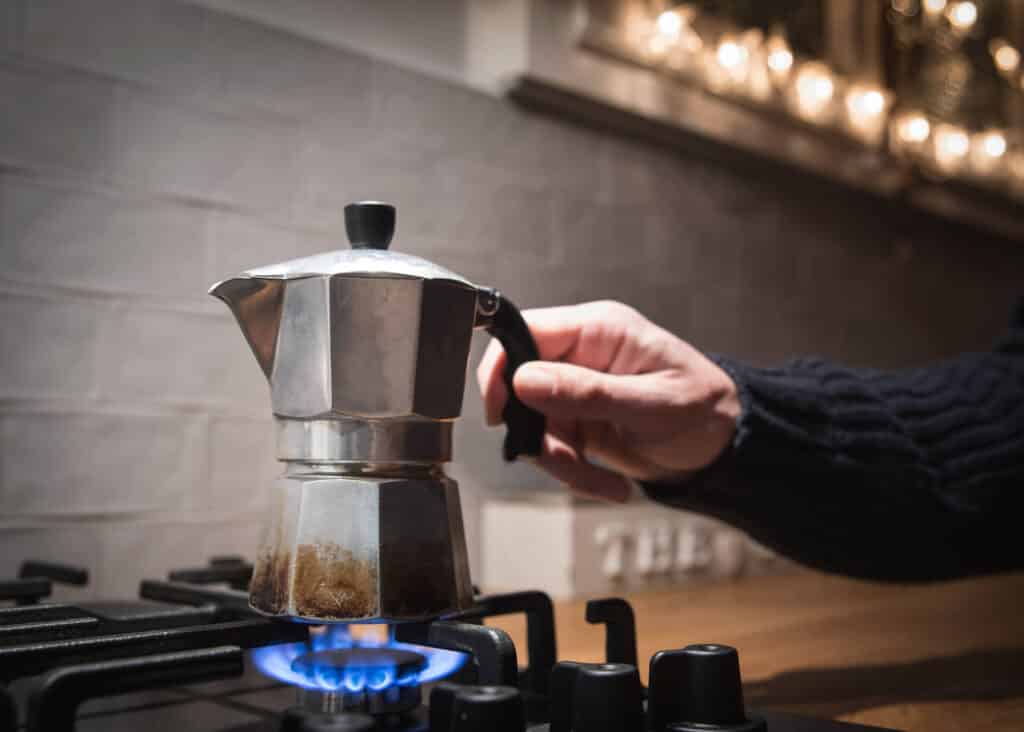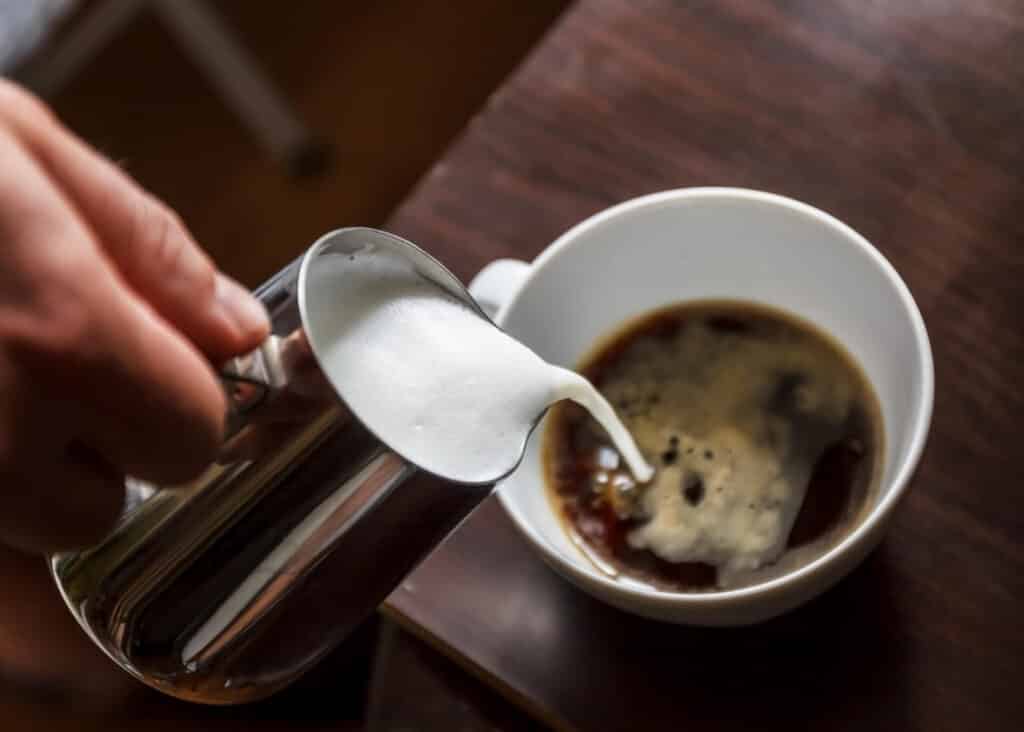You might have started using a Moka Pot as a simple way to prepare strong coffee, similar to an espresso. But can you make lattes or cappuccinos with it? What do baristas do to produce those beverages? They add milk to espresso, right? So you may wonder, can you put milk in a Moka Pot?
Can you brew coffee with milk instead of water?
Moka Pots are trendy in some parts of the world — like Italy, where they originated — but lesser known in others. If you are impressed with the ability of the classic stovetop coffee maker to produce a strong cup of coffee, you might think there are no limits to using it.
If the idea of pouring milk into your Moka Pot crossed your mind, ask yourself: “Can you brew coffee with milk instead of water?”
The purpose of any coffee brewing device, including a Moka Pot, is to extract the flavor compounds from the beans. Water is ideally suited for this task. When boiled in a Moka Pot, it becomes steam that facilitates the extraction process.
However, milk would not react to heat the same way as water. It tends to thicken when heated and would not move through the coffee grounds as smoothly as hot water.
As a result, milk may clog and damage even the best Moka Pot. Therefore, it is better to stop yourself from experimenting with it before it is too late. So the answer to the pressing question is “No”; you cannot brew Moka Pot coffee with milk instead of water.
Even if damage to your coffee maker was not a concern, you would not get great-tasting coffee from brewing coffee with milk.

What happens if you put milk in a Moka Pot?
Can you imagine putting milk into a water tank of an espresso machine? No, of course, you wouldn’t do that. Some espresso machines have a steam wand that can steam milk in a pitcher, but the milk never goes into the part of the machine where you pour the water. After all, you would not want to risk damaging an expensive appliance by misusing it!
Replacing water with milk in a Moka Pot is a bad idea for the same reason. Even though a Moka Pot is a much simpler appliance than a complex espresso maker, it still needs water to extract coffee from the grounds.
Milk is a common addition to coffee for those who find it too strong on its own. However, it needs to be added after the coffee is brewed with water, as milk does not respond to heat the same water does.
When heated, the milk proteins attract each other, and the milk curdles or lumps. It happens at a temperature lower than water’s boiling point. Therefore, it would prevent milk from rising when heated in a Moka Pot. Also, some of the compounds in milk are likely to burn during brewing, creating an unpleasant odor.
While low heat could reduce the risk of milk curdling, it wouldn’t get hot enough to extract the coffee beans. You’d need at least medium-high heat for that. And even if you did get enough extraction while brewing with milk to produce a cup of coffee, the real problem would be cleaning the Moka Pot afterward.

The sticky byproducts of milk will be very challenging to get rid of. Lactose, one of milk’s key compounds, is natural sugar, and sugars are sticky. If you’ve ended up brewing your coffee with milk in your Moka Pot, rinsing it may not be enough to get those burnt milk solids from the filter holes and crevices.
At best, the accumulated deposits that are too difficult to remove from your Moka Pot will give your coffee a bad taste. The sticky junk can also attract germs and mold that might make you sick.
Remember to be careful when cleaning aluminum Moka Pots, as you can’t put them into a dishwasher. Instead, you may want to run a vinegar brew cycle to deep-clean it.
Some stainless steel Moka brewers are dishwasher safe, and you might wonder if that gives you more room to replace water with milk in a Moka Pot. However, the answer is still the same: pouring milk into your Moka Pot is not a good idea.
A dishwasher might not catch residue accumulating around the pressure valve. A clog there could block the release of excess steam and result in Moka Pot leaking or even exploding. It is a safety issue, and it also has the potential to make a big mess in your kitchen.
Adding milk, which the Moka Pot is not designed to handle, dramatically increases the chance of the brewing process becoming a catastrophe. The fine holes of the Moka Pot’s filter basket can also clog easily, even though this is less of a safety issue than the risk of clogging the pressure valve.

Can you put milk in another type of coffee maker?
Replacing water with milk will not give a good result with any coffee brewing gadgets. In most cases, it will create a mess that will interfere with the operation of your coffee machine.
You should not put milk in a percolator, as it operates similarly to a Moka Pot. Even though percolators aren’t as vulnerable to exploding, why risk it? You’d still have all the other problems of the coffee pot being challenging to clean or useless for brewing coffee. With any coffee maker, a clog in a troublesome spot could lead to problems like burning or overflow.
Pouring milk into the water reservoir of a drip coffee maker or Keurig machine would be an even more expensive mistake than putting milk into your Moka Pot. Milk deposits will likely clog the water tubes and damage your automatic coffee machine beyond repair.
You can use your creativity when making coffee, and you can use it while experimenting with different coffee recipes or coffee add-ins. However, you must follow the manufacturer’s instructions when handling your coffee maker.
If you can’t ditch the idea of brewing coffee with milk for the sake of experiment, you can do it in the French press. Just pour some heated milk over the coffee grounds in your French Press and plunge it down after a few minutes as you would normally do. You won’t get anything like a latte or cappuccino, but you will satisfy your curiosity and won’t risk an explosion in your kitchen.
A French press can be used for frothing both hot and cold milk. So if you own both Moka Pot and a French press, brew strong coffee with the Moka Pot, froth the milk with the French press, and combine coffee with milk in a cup to make a hot or cold latte.
Can you make a cappuccino using a Moka Pot?
Moka Pot is an excellent little gadget for making cappuccino at home if you don’t have an espresso machine. However, as you may have figured by now, you need to heat the milk separately rather than pour it into a Moka Pot.
Even if putting milk in a Moka Pot worked the way you may fantasize, it wouldn’t be capable of creating milk foam for a cappuccino.
The easiest way is to use an electric milk frother that heats and froths the milk. Alternatively, you can heat milk in a pot or saucepan on the stove until small bubbles develop around the edges. Don’t let the milk boil and curdle!
Once the milk is hot, remove the pot from the burner, and use either a handheld milk frother or a whisk to introduce some air into the milk.
You can also pour the warm milk into a French press and pump the plunger up and down to achieve the desired milk texture.
Follow these steps to make a cappuccino at home using your Moka Pot:
- Brew coffee using a Moka Pot. For a single serving of cappuccino, you will need the equivalent of a shot of espresso (30ml).
- Heat milk in a saucepan until tiny bubbles start emerging. (Skip this step if you use an electric milk frother with a milk heating function).
- Pour the milk into a pitcher or a mug and froth it using a handheld milk frother. You’ll need equal amounts of milk and foam.
- Pour coffee into a cup.
- Pour hot milk into your coffee, using a spoon to hold back the foam.
- Once you have around two-thirds of your coffee cup full, top your cappuccino with a thick layer of foam. The classic cappuccino ratio is one-third espresso, one-third textured milk, and one-third foam.
- Sprinkle cinnamon or chocolate powder on top of the cappuccino if desired.

Can you make a latte using a Moka Pot?
Making a latte using a Moka Pot is similar to making a cappuccino. The main difference between a latte and a cappuccino is that a latte has less milk foam.
While a cappuccino is usually served in a small cup, the size of a latte cup is determined based on personal preference regarding how much milk you want to add.
A regular latte contains a single espresso shot and enough milk to fill an 11-15 oz cup. A large latte contains two espresso shots and milk in a 20-25 oz cup. Depending on the size of your Moka Pot, you might be able to brew the equivalent of two espresso shots at once.
You’ll need to use one of the techniques described above in the section on cappuccinos to heat and froth milk for your latte. However, you’ll probably need more milk than for a cappuccino.
Follow these steps to make a latte using a Moka Pot:
- Brew coffee using your Moka Pot.
- Heat milk on a stovetop using a saucepan until you see tiny bubbles forming around the edges. Make sure you don’t bring it to a boil.
- Froth the milk in a pitcher or a mug with a handheld milk frother.
- Depending on your mug size and personal preferences, pour 1 or 2 ounces of coffee into it.
- Add syrup or caramel sauce now if you like your latte flavored.
- Slowly pour the steamed milk into the cup using a spoon to hold back the foam.
- Pour the foam on last to form a thin layer at the top.
Now that you know how to make milk-based coffee drinks without causing a disaster, the possibilities are at your fingertips. Improving your home barista skills is easy if you follow some basic rules and use common sense.
The Italian Moka coffee maker is an excellent gadget that will allow you to create milk-based coffee drinks. However, Moka Pot is not designed for brewing using anything else but water, so you must avoid putting milk in it. Doing so will only lead to undesirable results, including ruined coffee, destroyed coffee maker, and possibly safety hazards. Of course, you wouldn’t want that, would you?
